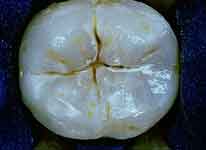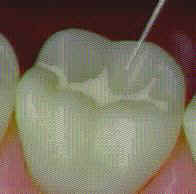An increasingly popular treatment in dentistry is making it possible
for kids to slip through childhood without a single cavity.
When parents ask their dentists what are the best ways to prevent their
children from getting cavities, dentists often respond
"SEALANTS!" These act as a barrier between bacteria (the cause
of decay) and the enamel on your teeth. The treatment uses clear plastic
fluids that dentists paint on the biting surfaces of permanent molars soon
after the teeth come in. Sealants are safe, dry in seconds, and last up to
five years.
Kids will still have to brush, floss and visit their dentists because
the sealant won't reach between the teeth, where cavities often
develop. But, sealants can cut molar cavities by more than 50 percent, and
can be especially helpful in areas without fluoridated water.
The dental sealant is one of the most revolutionary
materials available for protecting our children's teeth. For the past 18 years, a new
generation of children have been enjoying the benefits of protective sealants.
Most of them know nothing of what a cavity is and how a tooth is treated
when it has a cavity.
|
Below, is illustrated the steps involved with placing sealants and why and
how they work.
|

Before
A very normal first molar shows it's deep grooves
that can't help but to catch debris and build up stains.

During
The tooth is etched with some etching gel to open up the
pores
of the enamel so that the sealant can adhere.

After
The sealant is placed and it is hardened with a curing
light.
The biting surface of the tooth is now very well protected and the surface
is altered just enough so that food cannot become trapped on the surface
now.

This is a magnified view of the surface of the tooth
that clearly shows how deep and irregular the surace of the tooth actually is.

The grooves in our teeth are so deep, that in this
magnified image of
a single bristle from a toothbrush against the
groove of a tooth, the bristle is far too large to clean the groove.

The etching gel opens up the pores of the enamel so that
the sealant can flow into these pores and "grip" onto the tooth and protect the
tooth. If you have any questions regarding sealants, please
feel free to Ask
Dr.Ali
 The first step in maintaining a
healthy mouth is preventing tooth decay, and sealants can
offer major protection against cavities. Your teeth are
covered with a sticky film of bacteria, called plaque.
When you don't clean your teeth after eating, plaque
bacteria use sugar and starch in food as a source of
energy. The bacteria convert the sugar or starch into
harmful acids that attack tooth enamel for as long as
twenty minutes or more. Repeated attacks may cause the
enamel to break down, resulting in cavities.
The first step in maintaining a
healthy mouth is preventing tooth decay, and sealants can
offer major protection against cavities. Your teeth are
covered with a sticky film of bacteria, called plaque.
When you don't clean your teeth after eating, plaque
bacteria use sugar and starch in food as a source of
energy. The bacteria convert the sugar or starch into
harmful acids that attack tooth enamel for as long as
twenty minutes or more. Repeated attacks may cause the
enamel to break down, resulting in cavities.
How does a sealant help prevent decay?
A sealant is a plastic material that is usually applied
to the chewing surfaces of the back teeth — premolars
and molars. This plastic resin bonds into the depressions
and grooves (pits and fissures) of the chewing surfaces of
back teeth. The sealant acts as a barrier, protecting
enamel from plaque and acids.
Thorough brushing and flossing help remove food
particles and plaque from smooth surfaces of teeth. But
toothbrush bristles cannot reach all the way into the
depressions and grooves to extract food and plaque.
Sealants protect these vulnerable areas by "sealing
out" plaque and food.
Is sealant application a complicated procedure?
Sealants are easy for your dentist to apply, and it
takes only a few minutes to seal each tooth. The teeth
that will be sealed are cleaned. Then the chewing surfaces
are roughened with an acid solution to help the sealant
adhere to the tooth. The sealant is then 'painted' onto
the tooth enamel, where it bonds directly to the tooth and
hardens. Sometimes a special curing light is used to help
the sealant harden.
As long as the sealant remains intact, the tooth
surface will be protected from decay. Sealants hold up
well under the force of normal chewing and usually last
several years before a reapplication is needed. During
your regular dental visits, your dentist will check the
condition of the sealants and reapply them when necessary.
Sealants are just for kids, right?
The likelihood of developing pit and fissure decay
begins early in life, so children and teenagers are
obvious candidates. But adults can benefit from sealants
as well.
Key ingredients in preventing tooth decay and
maintaining a healthy mouth are twice-daily brushing with
an ADA-accepted fluoride toothpaste; cleaning between the
teeth daily with floss or interdental cleaners; eating a
balanced diet and limiting snacks; and visiting your
dentist regularly. Ask your dentist about whether sealants
can put extra power behind your prevention program.
|
|
![]()